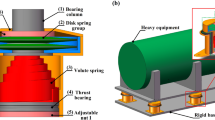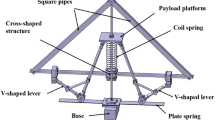Abstract
A compression bar-type quasi-zero stiffness (QZS) element is designed on the basis of the parallel principle of positive and negative stiffness by combining disc spring and coil spring. A vibration isolation platform supported by the compression bar type QZS element is constructed. First, the static analyses of the compression bar-type QZS element and QZS vibration isolation platform are investigated, and the force-displacement equations of each degree of freedom (DOF) of the QZS platform are derived. Second, the force transmissibility and dynamic characteristics under harmonic excitation are analyzed in detail and made a comparison with those of the equivalent linear isolation system. Results show that the vibration isolation performance (VIP) of the QZS isolation system is superior to that of the equivalent linear isolation system. The low-frequency VIP of the QZS system can be enhanced by increasing damping, reducing the stiffness ratio, or changing installation angle.
Similar content being viewed by others
References
R. A. Ibrahim, Recent advances in nonlinear passive vibration isolators, Journal of Sound and Vibration, 314(3–5) (2008) 371–452.
C. R. Liu and K. P. Yu, Accurate modeling and analysis of a typical nonlinear vibration isolator with quasi-zero stiffness, Nonlinear Dynamics, 100 (2020) 2141–2165.
Y. Q. Liu, L. L. Xu, C. F. Song, H. S. Gu and W. Ji, Dynamic characteristics of a quasi-zero stiffness vibration isolator with nonlinear stiffness and damping, Archive of Applied Mechanics, 89 (2019) 1743–1759.
Z. F. Hao and Q. J. Cao, The isolation characteristics of an archetypal dynamical model with stable-quasi-zero-stiffness, Journal of Sound and Vibration, 340 (2015) 61–79.
A. Carrella et al., Force and displacement transmissibility of a nonlinear isolator with high-static-low-dynamic-stiffness, International Journal of Mechanical Sciences, 55 (2012) 22–29.
J. X. Zhou et al., Nonlinear dynamic characteristics of a quasi-zero stiffness vibration isolator with cam-roller-spring mechanisms, Journal of Sound and Vibration, 346 (2015) 53–69.
T. D. Le and K. K. Ahn, Experimental investigation of a vibration isolation system using negative stiffness structure, International Journal of Mechanical Sciences, 70 (2013) 99–112.
H. Ding and L. Q. Chen, Nonlinear vibration of a slightly curved beam with quasi-zero-stiffness isolators, Nonlinear Dynamics, 95 (2019) 2367–2382.
X. C. Huang, X. T. Liu and H. X. Hua, On the characteristics of an ultra-low frequency nonlinear isolator using sliding beam as negative stiffness, Journal of Mechanical Science and Technology, 28 (2014) 813–822.
X. Liu, X. Huang and H. Hua, On the characteristics of a quasi-zero stiffness isolator using Euler buckled beam as negative stiffness corrector, Journal of Sound and Vibration, 332(14) (2013) 3359–3376.
Q. Li, Y. Zhu, D. F. Xu, J. C. Hu, W. Min and L. C. Pang, A negative stiffness vibration isolator using magnetic spring combined with rubber membrane, Journal of Mechanical Science and Technology, 27(3) (2013) 813–824.
Y. S. Zheng, X. N. Zhang, Y. J. Luo, Y. H. Zhang and S. L. Xie, Analytical study of a quasi-zero stiffness coupling using a torsion magnetic spring with negative stiffness, Mechanical Systems and Signal Processing, 100 (2018) 135–151.
G. X. Dong, X. N. Zhang, S. L. Xie, B. Yan and Y. J. Luo, Simulated and experimental studies on a high-static-low dynamic stiffness isolator using magnetic negative stiffness spring, Mechanical Systems and Signal Processing, 86 (2017) 188–203.
A. D. Shaw, S. A. Neild and D. J. Wagg, Dynamic analysis of high static low dynamic stiffness vibration isolation mounts, Journal of Sound and Vibration, 332(6) (2013) 1437–1455.
X. L. Wang, J. X. Zhou, D. L. Xu, H. J. Ouyang and Y. Duan, Force transmissibility of a two-stage vibration isolation system with quasi-zero stiffness, Nonlinear Dynamics, 87 (2017) 633–646.
X. Sun et al., Vibration isolation via a scissor-like structured platform, Journal of Sound and Vibration, 333(9) (2014) 2404–2420.
X. T. Sun and X. J. Jing, Multi-direction vibration isolation with quasi-zero stiffness by employing geometrical nonlinearity, Mechanical Systems and Signal Processing, 62–63 (2015) 149–163.
Z. J. Wu et al., A 6DOF passive vibration isolator using X-shape supporting structures, Journal of Sound and Vibration, 380 (2016) 90–111.
F. Z. Hu and X. J. Jing, A 6-DOF passive vibration isolator based on Stewart structure with X-shaped legs, Nonlinear Dynamics, 91 (2018) 157–185.
J. X. Zhou et al., A novel quasi-zero-stiffness strut and its applications in six-degree-of-freedom vibration isolation platform, Journal of Sound and Vibration, 394 (2017) 59–74.
T. Zhu, B. Cazzolato, W. S. P. Robertson and A. Zander, Vibration isolation using six degree-of-freedom quasi-zero stiffness magnetic levitation, Journal of Sound and Vibration, 358 (2015) 48–73.
W. S. Lu, Calculation of Disc Spring, Design and Manufacturing, Fudan University Press, Shanghai (1990) (in Chinese).
X. Z. Yi, C. Y. Zhang and Z. S. Yan, Study on mechanical characteristic parameters of disc spring, Journal of Yangtze University (Natural Science Edition: Science and Technology Volume), 4 (2007) 99–101 (in Chinese).
Z. H. Wang and X. L. Wang, Elastoplastic finite element analysis of disc spring, Aerospace Manufacturing Technology, 2 (2018) 19–22 (in Chinese).
Acknowledgments
This work is supported by the financial support from the Beijing Municipal Natural Science Foundation (No. 1182010), Open Topic Funding Project of Jiangsu Key Laboratory of Advanced Food Manufacturing Equipment and Technology (FM-201802), Top-notch Team Funding Project of Excellent Talents Plan of Xicheng District of Beijing and 2020 Research and Innovation Plan for Graduate Students in Jiangsu Province (KYCX20_ 1927).
Author information
Authors and Affiliations
Corresponding author
Additional information
Yanqi Liu is an Associate Professor of Beijing Key Laboratory of Environment Noise and Vibration, Beijing Municipal Institute of Labor Protection, Beijing, China. She received her Ph.D. in Mechanical Engineering from Beijing University of Technology. Her research interests include mechanical dynamics, nonlinear dynamics.
Chunfang Song is a Professor of Jiangsu Key Laboratory of Advanced Food Manufacturing Equipment and Technology, School of Mechanical Engineering, Jiangnan University, Wuxi, China. She received her Ph.D. in Engineering College from China Agricultural University. Her research interests include mechanical dynamics, nonlinear vibration and control.
Rights and permissions
About this article
Cite this article
Liu, Y., Ji, W., Gu, H. et al. Force transmissibility of a 6-DOF passive quasi-zero stiffness vibration isolation platform. J Mech Sci Technol 35, 2313–2324 (2021). https://doi.org/10.1007/s12206-021-0504-5
Received:
Revised:
Accepted:
Published:
Issue Date:
DOI: https://doi.org/10.1007/s12206-021-0504-5




